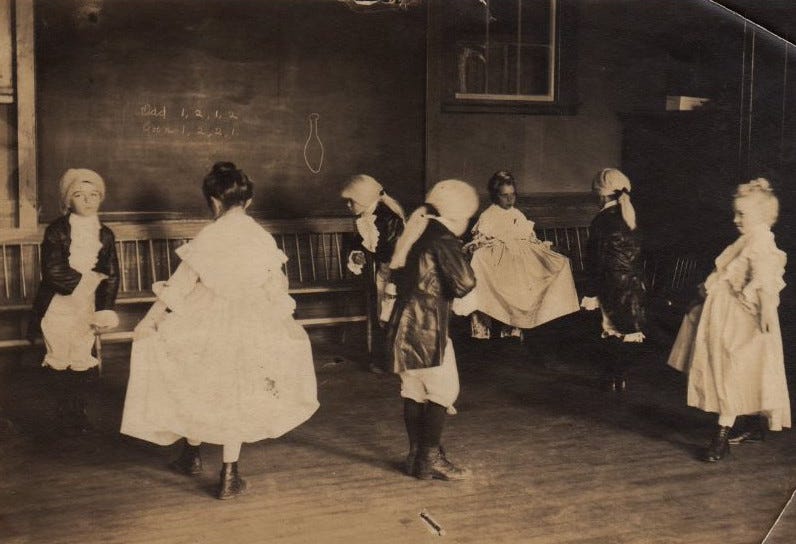Miscellany Mondays: Early 20th century historical pageants
Not quite Halloween, but definitely featured costumes galore!
Welcome or welcome back to History Buzz! If you’re a subscriber to the Buzz, thank you! If you’re new here, or you haven’t become a subscriber yet, please sign up for a subscription to have History Buzz delivered directly to your inbox.
Before the advent of radio and film, a historical pageant craze swept across the country. In the early 20th century, the American historical pageant combined traditional holidays, drama, and carnivals to confirm a patriotic image of a community and its history.
The Andover Historical Society stages a grand historical pageant n 1916
On Wednesday, June 7, 1916, from 3:00 to 5:00pm, the Andover Historical Society staged a grand historical pageant carnival on Brothers Field at Phillips Academy.
In 1914 - just two years before the Andover pageant - Ralph Davol published the book, A Handbook of American Pageantry.1 We don’t know if the Historical Society pageant organizers used the handbook, but the event they created follows the outline of the author’s ideal community pageant.
Davol’s handbook included advice on everything from location, time periods, scenes, and sample librettos and scripts, to PR and marketing.
The Historical Society created promotional posters that fit Davol’s standards for PR to a “T,”
“A poster…calls out thoughtful skill for creating appropriate designs – not the dreary, dull, machine-made posters – something fresh, insinuating, startling, to awaken the imagination. The pageant poster offers opportunity for…extravagance of composition.”
The Andover pageant followed Davol’s mandate that it be held outdoors,
“A major, or first class, pageant cannot be given in a theatre. It is cramped and smothered indoors . . . History is more convincing to an audience when the players stand with feet on terra firma...”
Of course!
The June 1916 program featured three major eras: Revolutionary, Civil War, and Present Day.
Scenes within each era followed Davol’s outline, interspersing local Andover stories with national patriotic stories. Old Father Time, scythe on his shoulder and hourglass in his hand, opened the pageant and announced each scene.
Andover’s local scenes included an early church-going family protected by the father, who wielded his gun against lurking local Native Americans; the founding of Phillips Academy; and Harriet Beecher Stowe and Uncle Tom’s Cabin.2
Including Uncle Sam and the Goddess of Liberty in the pageant was strongly recommended by Davol. In Andover, the Goddess of Liberty “in splendid array stood with her torch ready to crown the Civil War veterans.”
The G.A.R. veterans were escorted onto the field by a guard of local school girls. As recorded in the Townsman, “Mention must here be made too, of a miniature Uncle Sam, four years old – Hartwell Abbott, a lineal descendant of the Pilgrims.”
Following Davol’s outline, the pageant closed with scenes highlighting local talent. There were Old English costume dance demonstrations, a Boy Scout march, and maneuvers by the Phillips Academy military platoon.
American historical pageants in the early 20th century
Early 20th century historical pageants were typically created, managed, and performed by wealthy women. In fact, so important were pageants to their creators, that they formed the American Pageant Association to “protect from misuse a form of dramatic presentation.”
In A Handbook of American Pageantry, author Ralph Davol made his case for including different classes of people in the local pageant.
“Mixing with one’s fellow makes for mutual benefit. Something more is needed for a complete grasp of life than to know only a circle of one’s equals. To uplift the lower classes is possibly less important than to call down the snobbish, superior (so-called) classes of select society who draw their skirts away from the ‘vulgar herd’ from whom they sprung.”
However, for all of his high aspirations, the stories and representations in early 20th century historical pageantry reflected the class and racial prejudices of the day. In addition to artistic guidance on how to stage an ancient Greek allegory, Davol’s handbook gave advice on everything from how to engage members of the working class to what colors of grease paint to mix to create a desired darkened skin tone.
Photographs of Andover’s 1916 Historical Pageant illustrate the results of this advice. Davol instructed that pageants must include Native Americans. It’s clear that the actors in Andover’s Native American scene darkened their skin for the performance. Given the frequency of both traveling and locally-produced minstrel shows in Andover, we can be reasonably certain that the players in the Harriet Beecher Stowe Uncle Tom’s Cabin scene – Uncle Tom, Little Eva and Topsy – were portrayed in blackface.
All interpretations of history are viewed through the lens of the individual researcher, writer, and reader, and the time in which they live. Interpretations of America’s patriotic history through local community pageants were no different. As such, early 20th century historical pageants tell us much about the outlook and views of the upper class Americans who created them.
How about you? Did you ever participate in a pageant in school? Or maybe for a parade or other civic event?
Thanks for reading!
~Elaine
Ralph Davol, A Handbook or American Pageantry, https://www.google.com/books/edition/A_Handbook_of_American_Pageantry_by_Ralp/CaaEAAAAIAAJ?hl=en
Harriet Beecher Stowe lived in Andover 1852-1864, afterwards the family moved to Hartford, CT. Stowe wrote the Key to Uncle Tom’s Cabin while living in Andover. Her home on Bartlet Street, Andover, is now a dormitory for Phillips Academy. https://preservation.mhl.org/80-bartlet-street












Absolutely LOVED this post, Elaine! "Lurking local Native Americans and the Goddess of liberty" indeed!
Davol's advise that it was "important than to call down the snobbish, superior (so-called) classes of select society who draw their skirts away from the ‘vulgar herd’ from whom they sprung”.
That boy could certainly turn a phrase! Suffice to say, today, he'd be in trouble plenty!
We put on a play at Shawsheen school in the early 50s based on Stephen Foster’s life.